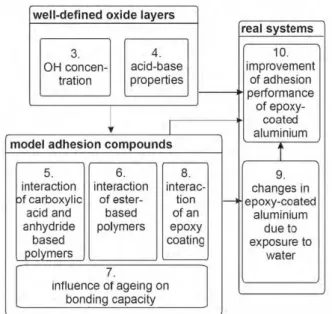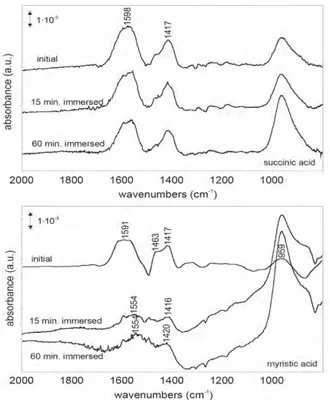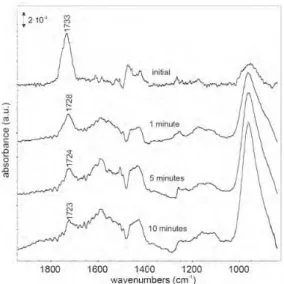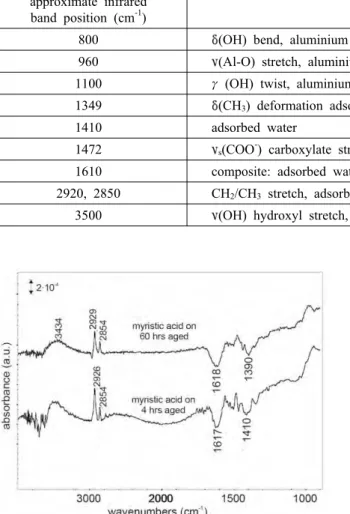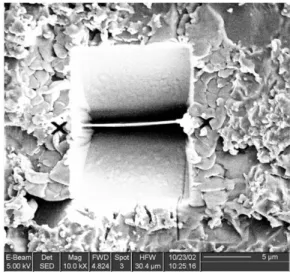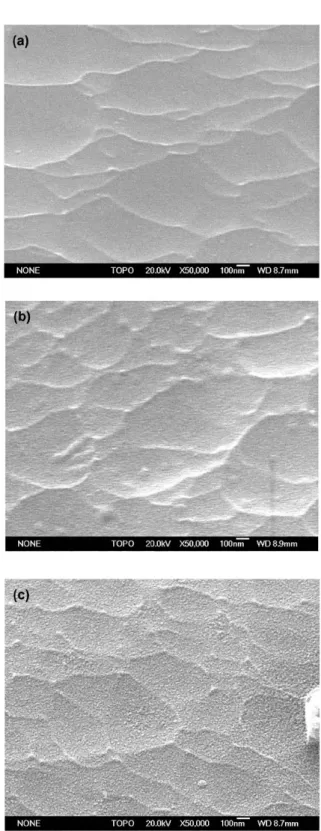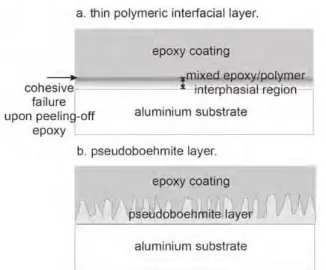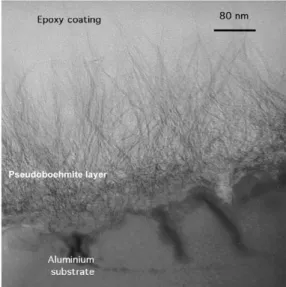Adhesion of Model Molecules to Metallic Surfaces, the Implications for Corrosion Protection
J.H.W. de Wit†, J. van den Brand, F.M. de Wit, and J.M.C. Mol
Corrosion Technology and Electrochemistry (Section SI) Department of Materials Science and Engineering,
Delft University of Technology and Netherlands Institute for Metals Research Mekelweg 2, 2628 CD Delft
The Netherlands
The majority of the described experimental results deal with relatively pure aluminium. Variations were made in the pretreatment of the aluminum substrates and an investigation was performed on the resulting changes in oxide layer composition and chemistry. Subsequently, the bonding behavior of the surfaces was investigated by using model adhesion molecules. These molecules were chosen to represent the bonding functionality of an organic polymer. They were applied onto the pretreated surfaces as a monolayer and the bonding behavior was studied using infrared reflection absorption spectroscopy. A direct and clear relation was found between the hydroxyl fraction on the oxide surfaces and the amount of molecules that subsequently bonded to the surface. Moreover, it was found that most bonds between the oxide surface and organic functional groups are not stable in the presence of water. The best performance was obtained using molecules, which are capable of chemisorption with the oxide surface. Finally, it was found that freshly prepared relatively pure aluminum substrates, which are left in air, rapidly lose their bonding capacity towards organic functional groups. This can be attributed to the adsorption of contamination and water to the oxide surface. In addition the adhesion of a typical epoxy-coated aluminum system was investigated during exposure to water at different temperatures. The coating was found to quite rapidly lose its adhesion upon exposure to water. This rapid loss of adhesion corresponds well with the data where it was demonstrated that the studied epoxy coating only bonds through physisorptive hydrogen bonding, these bonds not being stable in the presence of water.
After the initial loss the adhesion of the coating was however found to recover again and even exceeded the adhesion prior to exposure. The improvement could be ascribed to the growth of a thin oxyhydroxide layer on the aluminum substrate, which forms a new, water-stable and stronger bond with the epoxy coating.
Two routes for improvement of adhesion are finally decribed including an interphasial polymeric thin layer and a treatment in boiling water of the substrate before coating takes place. The adhesion properties were finely also studied as a function of the Mg content of the alloys. It was shown that an enrichment of Mg in the oxide could take place when Mg containing alloys are heat-treated. It is expected that for these alloys the (hydr)oxide fraction also depends on the pre-treatment and on the distribution of magnesium as compared to the aluminium hydroxides, with a direct impact on adhesive properties.
Keywords : adhesion, molecular bonding, polymer-metal interfaces
†Corresponding author: J.H.W. de Wit@tudelft.nl
1. Introduction
Good adhesion of coatings to metallic substrates is of great importance for good protection against corrosion. If adhesion is strong, not just by mechanical pinning, but by proper chemical bond with a high lateral density, prop- erties of polymers like the penetration rate of water and even the saturation value of water in coatings are of little importance for the behaviour of the coatings in practice.
Of course the mechanical properties of interphase layers like passive films and artificial conversion layers are also very relevant.
In this paper we will focus on the question how poly- mers and especially epoxy layers bond to aluminium (hydr)oxide as a function of the surface pre-treatment.
Thus we studied the bond strength as a function of the morphology, structure and composition of the surface- lay- er on the aluminium alloy. The chemistry of the oxide layer should be such that the functional groups of the poly- mer can form a strong chemical bond. The bonds should
also be stable in the presence of water, because water will eventually always penetrate the coating and reach the interface. Water would enable corrosion if present as a separate mostly impure phase at the interface, therefore condensation of an aqueous phase should be prevented.
“Perfect” adhesion of the polymer would prevent con- densation completely. Most aluminium alloys do suffer from intermetallic inclusions, or as in the case of magne- sium containing alloys behave locally quite different due to the formation of carbonates, which will influence the bonding process. In order to obtain fundamental knowl- edge on the adhesion process we simplified the system dealt with in this paper by using relatively pure aluminium AA1050 as a substrate.
The metal-polymer interface is not directly accessible for sophisticated measuring techniques like XPS (X-ray photoelectron spectroscopy) and FTIR-RAS (Infrared re- flection absorption spectroscopy). Therefore we selected a number of model molecules, representing the functional groups of the relevant polymers, to be applied as a mono- molecular layer on the substrate surfaces. In this way the interaction with the surface could be studied into detail.
It also enabled us to study the influence of ageing of the surfaces on the resulting bond strength. XPS was used to study the chemistry of the surface, particularly the ratio O/OH as a function of pre-treatment. When using infrared reflection absorption spectroscopy the incident beam comes in at an almost grazing angle (e.g.>75 degrees with respect to the surface normal) on a reflective substrate, having a high refractive index. This causes enhancement of the p-component while the s-component is almost com- pletely cancelled out due to destructive interference, s be- ing parallel to the plane of incidence and the p perpendicu- lar to the plane of incidence.1)
The enhancement of the p-component makes it a very sensitive measuring technique. Further advantages of hav- ing a high angle of incidence is enhancement of the inves- tigated area and a longer pathway of the infrared light through an absorbing over layer on the reflecting metallic substrates. These advantages make the technique highly suitable for studying very thin layers applied on reflective substrates, for example monolayers of organic molecules adsorbed on metallic substrates.
Next to these techniques also ellipsometry and various adhesion test methods were performed including the so-called NMP testing. NMP (N-methyl pyrrolidone, C5H9NO) is a highly polar solvent. It is capable of forming strong hydrogen bonds, allowing it to rapidly diffuse into organic coatings and causing extensive swelling. Due to the swelling, shear stresses are imposed at the metal-coat- ing interface. These shear stresses are in most cases re-
laxed by delamination of the coating, with a longer time until delamination indicating a better adhesion.2)
The data obtained on model molecules were then trans- lated to and compared with the behaviour of real coatings.
The study of the real systems included exposure to water following the resulting changes in bond strength. The ulti- mate goal of our investigations is the design of real coating systems with optimized bond capacity.
2. The interface system
The real coated system consisted of:
Epoxycoating: DGBA(diclycidyl ether of bisphenol-A) (Epikote 1001), cured using a poly(amide) based agent (Versamid 115) on 99.5 % pure AA1050.
Five different types of well defined aluminium surfaces based were studied:
∙Anhydrous amorphous aluminium oxide ∙Evaporated and oxidised aluminium ∙Acid pretreated aluminium
∙Alkaline pretreated aluminium ∙Pseudoboehmite oxide
To model an anhydride grafted or copolymerised poly- olefin we used:
∙Succinic anhydride ∙Succinic acid
and to model an aliphatic monifunctional carboxylic acid we used:
∙Myristic acid
Model ester functional groups were:
∙Glycol di-(monomethylsuccinic acid) ester ∙Dimethyl adipate
For a realistic interpretation of the interface with a true epoxycoating we used different model molecules like N, N, dimethylsuccinamide and N-methyldiethanolamine, not discussed in this paper.
3. Overview of the type of results
We will successively describe the results following the scheme given in Fig. 1.
Fig. 1. Showing the various topics described in the paper. 1 and 2 have been omitted from this paper, 3 and 4 are described in paragraph 5, 5-8 are described in paragraph 6 and 7, while 9-10 are discussed in paragraphs 8 and 9.
4. Well defined oxide layers
The composition of the various aluminum oxide layers has been determined in terms of an O/Al atomic ratio and a hydroxyl fraction. The O/Al atomic ratio is determined from the resolved photoelectron intensities while the hy- droxyl fraction is determined from curve-fitting; see ref 3-4 for a detailed description of the procedures. It is im- portant to understand that the contribution to the O 1s peak intensity from contamination by e.g. alcohols esters and carbonates has been corrected for. Although the O/Al atomic ratio and hydroxyl fraction are related to each oth- er, their values have been obtained from independent methods. A linear relation however exists between the hy- droxyl fraction and the O/Al atomic ratio. The hydroxyl fraction of an anhydrous aluminum oxide (Al2O3) is zero and it has an O/Al atomic ratio of 1.5 while the hydroxyl
Fig. 2. Comparison between O/Al atomic ratios as determined from photoelectron intensities and hydroxyl fractions from curve fitting of the photoelectron spectra as measured for the different types of aluminum oxide layers. The solid line represents the relation predicted between the O/Al atomic ratio and hydroxyl fraction for different samples of the same oxide. The error margin, corresponding to the spread of the values as determined for different samples of the same type of oxide, is for most oxides smaller than the symbol size
fraction of crystalline boehmite (AlOOH) is 0.5 and it has an O/Al atomic ratio of 2.0. This linear relationship allows a direct comparison between the results as obtained in this study. In Fig. 2, the experimentally determined O/Al atom- ic ratio is plotted versus the hydroxyl fraction for the dif- ferent studied oxide layers, together with a line corre- sponding to the linear relationship between the two parameters. An excellent correlation is evident between the O/Al atomic ratio and hydroxyl fraction as obtained with the two different methods. Only for the pseudo- boehmite oxide the determined O/Al atomic ratio and the hydroxyl fraction do not match.
This discrepancy can be explained from the fact that the pseudoboehmite oxide is porous and the surface of the layer is rough, which is not the case for the other types of oxides studied. This likely results in an incorrectly determined O/Al atomic ratio. Angle resolved XPS meas- urements also showed that the oxide layer is enriched in OH in the outer layers. This clear image of the ox- ide-structure forms a sound base for the later interpretation of the interface interactions with model molecules and polymers.
5. Model adhesion compounds
5.1 Interaction of carboxylic and anhydride based polymers
The anhydride functional group in succinic anhydride
is hydrolysed upon adsorption. This occurs for all the dif- ferently prepared aluminum substrates. The reaction pro- ceeds through physisorbed water on the oxide surface. As a result, succinic acid, having two carboxylic acid func- tional groups, is formed. Both of the carboxylic acid groups are subsequently deprotonated on the oxide surface to form a coordinatively bonded carboxylate. More anhy- dride groups are being hydrolyzed than are subsequently being chemisorbed as a carboxylate on the oxide surface, as evidenced from the clear presence of a remaining ν (C=O) carbonyl stretching vibration at 1724 cm-1 in the spectrum not shown here. For myristic acid, deprotonation of the carboxylic acid group also occurs upon adsorption on the differently prepared aluminum substrates. The chemisorption of succinic acid to an aluminiumoxide is schematically shown in Fig. 3.
An example of the IR spectrum for succinic acid and also for myristic acid is given in Fig. 4, which shows clear intensive peaks at 1588, 1417 and around 900 cm-1, re- spectively representing COO-, adsorbed water and con- tamination for 1588 cm-1, adsorbed water for 1417 cm-1 and Al-O/Al-OH around 900 cm-1. In this Fig. it is also shown that exposure to water does not influence the bi- functional succinic acid but very strongly the monofunc- tional myristic acid. Obviously the monodentate does not bond well enough; its place at the surface is taken by wa-
Fig. 3. Illustration of chemisorption of succinic acid on an aluminum oxide surface through the consumption of hydroxyls on the oxide surface.
Fig. 4. FTIR-RAS spectra for succinic acid (top) and myristic acid (bottom) on the alkaline pretreated aluminum after immersion in triple deionised water for the indicated period.
ter, which is also very clearly visible in the broadening of the Al-O peak due to OH formation. Not shown here is that also for the monodentate molecules the peak-in- tensity is very much dependent on the OH density, thus dependent on the oxide surface pretreatment.
5.2 Interaction of ester based polymers
In Fig. 5 it can clearly be observed that for the glycol di-(monomethylsuccinic acid) the amount of molecules ad- sorbed is determined by the OH fraction at the surface.
The acid pretreated surface with the highest number of OH groups at the surface shows the highest infrared peak intensity. The bonds are not stable (though the bonds are a bit stronger than for dimethyl adipate, not shown here) in the presence of water as can be seen in Fig. 6.
To evaluate the stability of the bonds in water, im- mersion experiments in triple deionised water were per- formed on the oxide layers with adsorbed molecules at room temperature. The dimethyl adipate compound does not show a stable bond. Already after 1 minute of im- mersion, all molecules have become desorbed, as evi- denced by absence of the (C=O) carbonyl stretching vibration. The glycol di-(monomethylsuccinic acid) ester shows a more stable adsorption. In Fig. 6, infrared spectra are shown obtained initially and after 1, 5 and 10 minutes
Fig. 5. Relation between the "(C=O) carbonyl stretching vibration peak area of glycol di(monomethylsuccinic acid) ester molecules at saturation coverage on the different aluminum oxides versus their hydroxyl fraction as determined from the XPS measurements.
Fig. 6. FTIR-RAS spectra of glycol di-(monomethylsuccinic acid) ester molecules on the evaporated and oxidised type of aluminum, after different immersion times in room temperature deionised water.
of immersion in water for the evaporated and oxidised aluminum. After 1 minute, a significant part of the mole- cules have become desorbed and the (C=O) carbonyl peak is shifted to lower wavenumber.
For longer immersion times, more molecules become desorbed and the (C=O) carbonyl peak shifts further to lower wave number. Broad bands develop in the spectrum around 1590 cm-1 and around 1430 cm-1. These are due to water molecules, adsorbed on the oxide surface.5) Moreover, the growth of the main Al-O peak at 950 cm-1 is observed, which is due to the development of broad shoulders, corresponding to hydroxyl bending vibrations.6)
It indicates growth and through-film hydroxylation of the oxide layer, due to a direct contact of the oxide surface with water.
6. Ageing and bonding capacity (including model)
We expect changes in the bonding capacity whenever the OH covered surface changes due to exposure to am- bient air, which is the normal situation during coating procedures. Therefore we studied the infrared spectra of aluminium substrates, aged for 1, 4, 16 and 60 hours in air. The spectra as given in Fig. 7 show the changes in time.
A summary of the bands observed upon ageing is given in Table 1. Without going into detail it is obvious form this table that both contamination by organic species and water from the atmosphere do show up, which will prob- ably impede the functional groups of coating systems to bond to the substrate. This is indeed visible in Fig. 8, where the lower signal for the CH2/CH3 stretching frequen- cies around 3000-2800 cm-1, after prolonged exposure to air is shown.
When performing the same measurements on substrates aged in pure and dry nitrogen hardly any adsorption from the gaseous phase was observed. A summary of the dimin- ishing bonding capacity for the two cases is given in Fig.
9.
Fig. 7. FTIR-RAS spectra from aluminium substrates after ageing in ambient air for indicated periods. Spectra are shown with respect to a background prior to ageing and therefore only show the changes that have occurred inn the ageing process. The sharp bands at around 3700 cm-1 are experimental artefacts and are due to water in the infrared compartment.
Table 1. Infrared peak positions and assignments for the various infrared peaks observed for ageing of an aluminium substrate in ambient air
approximate infrared
band position (cm-1) assignment
800 δ(OH) bend, aluminium oxyhydroxide region 960 ν(Al-O) stretch, aluminium oxide
1100 γ(OH) twist, aluminium oxyhydroxide region 1349 δ(CH3) deformation adsorbed contamination
1410 adsorbed water
1472 νs(COO-) carboxylate stretch, adsorbed contamination
1610 composite: adsorbed water and νas(COO-) crboxylate stretc, adsorbed contamination 2920, 2850 CH2/CH3 stretch, adsorbed contamination
3500 ν(OH) hydroxyl stretch, adsorbed water and aluminium oxyhydroxide region
Fig. 8. FTIR-RAS spectra obtained after the adsorption of myristic acid on a substrate aged in ambient air for 60 hours (top) and 4 hours (middle). Spectra are shown with respect to a background prior to ageing and therefore only show the changes that have occurred in the ageing process. The sharp bands at around 3700 cm-1 are an experimental artifact and are due to water in the infrared compartment.
The amount of chemisorbed myristic molecules, being a measure for the bonding capacity of the oxide surface, can be evaluated from the total integrated peak intensity in the 3000-2800 cm-1 region, where the CH2 and CH3
stretching vibrations are located, with more adsorbed mol- ecules also resulting in more intense peaks. The total in- tegrated peak intensities were determined after subtraction of a linear background and are plotted in Fig. 9 as a func- tion of ageing time. The results are given relative to results obtained for a freshly prepared substrate. It shows clearly that the decreasing bonding capacity is greater for the air-exposed samples. Absolute information on the cover- age, i.e. the amount of adsorbed molecules per unit of
Fig. 9. Bonding capacity of the aluminum oxide surfaces towards chemisorption of carboxylic acid based molecule as a function of ageing time of the aluminum substrate in ambient air and in a clean, dry nitrogen environment.
surface area was not obtained. For the current discussion, the relative decrease is however considered to be most important. Based upon these results a model was designed, which schematically shows the changes to the surface, the oxide layer and the influence this has on the subsequent adsorption of myristic acid as given in Fig. 10. The model shows the initial state with some water molecules at the aluminum oxide surface. After about 20 hours of ageing carboxylic acid based contamination and water adsorb to the surface. A hydroxylated region is formed through a dissolution and precipitation mechanism. Upon adsorption of myristic acid part of the adsorbed water is desorbed.
Myristic acid is not capable to displace all contamination, resulting in the observed decrease of the bonding capacity.
Fig. 10. Schematic of the processes occurring during ageing of an aluminum oxide layer in ambient airand the subsequent influence on the reactivity towards chemisorption of a carboxylic acid based molecule.
7. Epoxy-Aluminium exposed to water (in- cluding model)
Before discussing the behaviour of the real epoxy- caot- ed system it is important to stipulate that we did also do experiments, not discussed here, with some model mole-
cules simulating the functional groups of the epoxy. We refer to our publications on this subject for details.7)-12) These experiments showed that bonding by the model mol- ecules took place through hydrogen bonds with the OH groups at the surface. The bonds again were not stable in the presence of water. This suggests that also the bonds of epoxy coatings to the substrate, exposed to an aqueous phase, are probably not stable in time. Only with a high density of OH groups a good bonding strength is expected.
To investigate the epoxy-aluminum interface, before and after exposure to water, a TEM investigation was per- formed. For this purpose, cross section lamellae were di- rectly prepared from coated samples using a Focused Ion beam (FIB). The procedure is illustrated in Fig. 11 where a coated sample is shown. The lamella, shown in the cen- tre, was prepared by milling away squares on both sides, all the way into the aluminum substrate. After some further thinning, this lamella was cut free and used directly as a TEM slice. The FIB/TEM work performed on these poly- mer-coated substrates is discussed elsewhere in detail.13),14) In Fig. 12, TEM cross-section images are shown for re- spectively a sample, which was exposed for 600 hrs to 50℃ deionised water and for a not-exposed sample. For the not-exposed sample, the interfacial region can be seen to be sharp with no apparent irregularities and also the epoxy coating appears homogeneous. The exposed sample on the other hand clearly shows a very thin layer, having a thickness of around 30 nm, to be present between the epoxy coating and the aluminum substrate. The layer is shown at a higher magnification in Fig 12c. Diffraction patterns obtained in the TEM on the layer showed it to be fully amorphous.
Fig. 11. SEM image obtained during FIB preparation of TEM cross section slices of theepoxy-coated aluminum system.
Fig. 12. TEM cross section images of (a) an epoxy-coated aluminum sample exposed for 600 hrs to 50℃ deionised water, (b) a not-exposed sample and (c) the same as (a) only at a higher magnification.
Fig. 13. SEM images of a not-exposed coating (top) and a coating exposed for 800 hrs to 40℃ water(bottom). The coating is obtained by peeling-off from exposed and not-exposedepoxy-coated aluminum samples and is obtained on the substrate-side of the coatings (theside that was attached to the aluminum substrate).
To allow for a detailed investigation of the coatings, they were separated from the substrates by peeling-off manually from exposed and not-exposed samples. In Fig.
13, SEM images of exposed and not-exposed coatings are shown, as obtained on the substrate-side of the coating (which is the side previously adhered to the aluminum substrate before peeling-off).
The not-exposed coating shows a surface with small globular protrusions. These are the opposite of shallow holes on the aluminum side and are due to the alkaline etching procedure. The same globular protrusions are also visible on a sample exposed for 800 hours to 40℃ de- ionised water, but the coating surface appears rougher.
This is because more force was necessary to remove the coating as a result of the improved adhesion due to ex- posure to water. This results in some deformation of the
coating. Besides this, no clear morphological differences are observed between the exposed and the not-exposed coating, also not at higher magnifications.
FTIR-ATR investigations combined with XPS measure- ments of the peeled-off coatings did show no differences due to exposure to water. However the substrate did show differences due to the exposure to water:
In Fig. 14, SEM images are shown of the aluminum substrate after manually peeling-off the epoxy-coating.
Images are shown for three different exposure times of samples to 40℃ deionised water. Fig. 14 a shows the alu- minum substrate of a not-exposed sample. The large, shal- low holes that are visible on the substrate are due to the alkaline etching pretreatment of the substrates. For the sub- strate of a sample exposed for 200 hrs to 40℃ deionised water, see Fig. 14b, inside these holes, small globular par- ticles are present, having sizes smaller than 10 nm. For the substrate exposed for 800 hrs to 40℃ deionised water, see Fig. 14c, more of these globular particles are present.
These globular particles likely correspond to the layer that is observed in the TEM images cf Fig. 12.
FTIR-RAS investigations of the substrates in Fig. 14 did not give any evidence of the original epoxy coatings, which suggests that peeling off of the coatings did take place as a failure of the adhesive bond between the coating and the substrate. For longer exposed coated samples the spectra show the development of broader bands around 1073 and 758 cm-1, which indicate the hydroxylation of the oxide layer at the interface. The bands can be ascribed respectively to δ(OH) bending and γ(OH) twisting vi- brations and their positions and broadness indicate the characteristics of an amorphous, pseudoboehmite-type alu- minum oxyhydroxide.6),15)
Ellipsometry showed that the thickness of the aluminum oxyhydroide layer formed at the interface as a function of exposure time increases in time and with temperature.
Peeling off experiments did show for exposed samples did show an initial loss of adhesion and a later recovery of the adhesion strength. For a detailed discussion we refer to previous publications.10),11)
Based on these data we designed a model for the adhe- sion mechanism of epoxies to aluminum substrates as pre- sented in Fig. 15. Upon exposure of the epoxy-coated alu- minum, water diffuses into the epoxy coating, judging from TGA measurements not discussed here considerably more than in a free coating. The additional water can be attributed to water accumulating at the interface, causing loss of adhesion because the hydrogen bonds are not stable in the presence of water as discussed before. It was ob- served that when the epoxy coating was rapidly removed from the substrate directly after exposure, small droplets
Fig. 14. SEM images for aluminum substrates, obtained from epoxy-coated aluminum samples (a) not-exposed and exposed to 40℃ water for (b) 200, (c) 800 hours.
of water were present, which instantaneously evaporated.
The water present at the interface furthermore causes Al-O bond breaking and the oxide will locally dissolve. Hydrox- yl and oxygen ions will start diffusing inwards while the
Fig. 15. Schematic of the processes occurring upon exposure of the epoxy-coated aluminum system to water.
Al ions diffuse outwards, followed by precipitaion of oxyhydroxides. This mechanism is known as the dis- solution-precipitation mechanism.16)-18) FTIR-RAS, XPS and TEM together showed that the layer is an amorphous pseudoboehmite type of oxyhydroxide. Finally the grow- ing oxyhydroxide layer re-establishes and improves con- tact with the epoxy coating. Adhesion shows recovery after the initial loss. The growth of the layer stops due to the limited amount of water at the interface. NMP testing on samples where a hydration inhibitor was used, showed that the adhesion recovery process does only occur when then oxyhydroxide layer has been established.
8. Routes for improved adhesion and con- clusions
Based on the information as discussed above two differ- ent methods were followed to improve the adhesion per- formance of an epoxy coating on an aluminum substrate.
In Fig. 16, a schematic picture of these two approaches is shown.
The first method was by adding a thin polymeric layer (i.e. an interfacial layer) between the aluminum substrate and an epoxy coating. The functional groups were deliber- ately chosen so as to be able to chemisorb onto the oxide surface and to be capable of being involved in the curing reaction with the epoxy. For the details we refer to earlier publications.1),11) The bond between the organic overlayer and the substrate was indeed found to be improved.
Removal of the epoxy coating after curing results for all improved systems in cohesive failure in an interphasial region while for the unmodified system adhesive failure occurs between epoxy and aluminum.Significant chemical
Fig. 16. Schematic of the systems developed using the two methods of adhesion performance improvement. (a). Adding a thin polymeric layer between aluminum and epoxy. As a result of reaction between epoxy and the polymeric layer, this results in the formation of a mixed epoxy/polymer interphasial region.
(b). Hydration of the aluminum substrate by immersion in boiling water, resulting in the formation of a porous pseudoboehmite oxyhydroxide layer. The epoxy coating fully penetrates into this porous structure.
changes to the polymeric interfacial layer are observed af- ter application and curing of the epoxy coating. The fol- lowing process is likely to take place at the interface after application of the resin. First, the polymeric layer is largely dissolved due to the solvents. Mixing of the polymer and the epoxy resin constituents can then take place and the functional groups of the polymeric interfacial layer are di- rectly involved in the curing reaction with the epoxy. This eventually results in the formation of a mixed epoxy/poly- mer interphasial region, see Fig. 16a.
The second method of adhesion improvement was by hydration of the aluminum substrates by immersion in boiling water, see Fig. 16b. A pseudoboehmite oxy- hydroxide layer is formed on the aluminum substrate, hav- ing a large number of hydroxyls on its surface and being porous with consequently a large surface area. The epoxy coating was found to be well-capable of penetrating this porous structure as can be seen in Fig. 17. Most types of organic functional groups bond through hydroxyls on the oxide surface. But, the bonding mechanism itself with organic functional groups is however not different for pseudoboehmite as compared to other typical aluminum oxides. The large number of hydroxyls on the pseudo- boehmite surface and the large surface area will therefore result in a high density of bonds with the epoxy coating.
This will result in high initial adhesion strength and water can then not easily accumulate at the interface, because
Fig. 17. TEM cross section image of the epoxy-pseudoboehmite- aluminium system. In thecentre the pseudoboehmite oxy- hydroxide layer is visible. The epoxy coating is observed tohave fully penetrated into the porous layer.
there is a very low number of sites at which there is no adhesion. Indeed, the pseudoboehmite system shows a sig- nificant improvement of the initial adhesion strength and a very good durability in aqueous environments
References
1. J. Van den Brand, On the adhesion between aluminium and plolymers, Ph.D Thesis, Delft University of Technology, 2004, ISBN 90-77172-10-6
2. J. Van ooij, R. A. edwards, A. Sabata, J. Zappia, J.
of Adhesion Science and Technology, 7, 897 (1993).
3. J. van den Brand, W. G. Sloof, H. Terryn, and J. H.
W. de Wit, Surface and Interface Analysis, 36, 81 (2004).
4. J. van den Brand, P. C. Snijders, W. G. Sloof, H. Terryn, and J. H. W. de Wit, Journal of Physical Chemistry B, 108, 6017 (2004).
5. L. Vlaev, D.Damyanov, M.M. Mohammed, Colloid and Surfaces, 36, 427 (1989).
6. C.A. Melendes, S.van Gils, H.Terryn, Electrochemistry Communications, 3, 737 (2001).
7. J. van den Brand, O. Blajiev, P.C.J. Beentjes, H. Terryn and J. H. W. de Wit, Langmuir, 20, 6308 (2004).
8. J. van den Brand, O. Blajiev, P. C. J. Beentjes, H. Terryn and J. H. W. de Wit, Langmuir, 20, 6318 (2004).
9. J. van den Brand, S. van Gils, P. C. J. Beentjes, H.
Terryn, and J. H. W. de Wit, Applied Surface Science accepted for publication, 2004.
10. J. van den Brand, S. van Gils, H. Terryn, W. G. Sloof, and J. H. W. de Wit. “Changes at the epoxy-aluminium interface due to exposure to water”. Progress in organic coatings, 2004.
11. J. van den Brand, S. van Gils, P. C. J. Beentjes, H.
Terryn, and J. H. W. de Wit. “Improving the adhesion between epoxy coatings and aluminium substrates by either using thin polymer layers or by hydration of the aluminium”. Progress in organic coatings, 2004.
12. J. van den Brand, H. Terryn and J.H.W. de Wit, ATB Metallurgy, 43, 72 (2003).
13. V. G. M. Sivel, J. van den Brand, W. R. Wang, H.
Mohdadi, F. D. Tichelaar, P. F. A. Alkemade, H. W.
Zandbergen, Journal of Microscopy, 214, 237 (2004).
14. V.G.M. Sivel, “Dualbeam and FIB capability applied to metals research”; FEI Application Note, 2004.
15. S. S. van Gils, C. A. Melendres, H. Terryn, Surface and Interface Analysis, 35, 387 (2003).
16. M. R. Alexander, Surface and Interface Analysis, 29, 468 (2000).
17. M. R. Alexander, G. E. Thompson, G. Beamson, ATB Metallurgy, 3, 133 (2000).
18. S. van Gils, H. Terryn, E. Stijns, G. E. Thompson, M.
R. Alexander, ATB Metallurgy, 43, 358 (2003).
